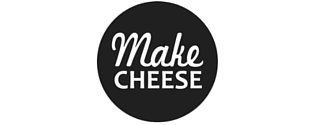
I use a lot of different products to help me in all aspects of my cheesemaking. Out of all of them, a good sanitizer is one of the most important products to use effectively. If your equipment and surfaces aren’t clean, great cheese isn’t possible. But what is clean? Check it out!
RULE OF THUMB
Sanitation is as important as any other step in the cheese making process.
GETTING THE MOST OUT OF YOUR INGREDIENTS
Proper sanitation is not only about your health when consuming cheese, it is also about giving the enzymes and bacteria (your rennet and starter cultures) a chance to flourish in the milk.
For example, rennet is a very sensitive and finicky enzyme. It can easily be rendered inactive or useless if it finds itself fighting off the wrong mineral. The same can be said about bacterial cultures, when you add them to the milk they may be forced to compete with other unwanted bacteria in your milk and the end outcome will be an off-flavour.
WHAT TO DO…
STEP 1: CLEAN EVERYTHING IN SOAP AND WATER
Get out your dish-soap and scrub and remove any debris or caked on material on your equipment.
STEP 2: SANITIZE EVERYTHING
You can sanitize your equipment by either 1) Boiling it in hot water or 2) Using an acid-based sanitizer.
- BOILING YOUR EQUPMENT: Put all your cheese making equipment into a stockpot filled with water and boil for at least 10 minutes. For this reason, plastic equipment for cheese making is not recommended for cheese making. So try and use stainless steel measuring spoons, ladles and knives. Cheesecloth is also safe to boil.
You can boil your equipment the night before making cheese or on the day of.
- ACID-BASED SANITIZERS: This is an alternative to boiling your equipment. Most acid-based sanitizers will kill possible contaminants within 1-2 minutes.
These sanitizers should be properly diluted in water. Let equipment dry off, no rinsing!
Soft plastics aren’t recommended for soaking in acid-based sanitizers. The sanitizer bottles should be stored in a safe area away from the reach of children. Please read the instruction on the label for best use.
Sanitizing should all be done the evening before making cheese.
My favorite sanitizer is Star San. It is an acid-based, no-rinse sanitizer that is effective and easy to use. StarSan works in just 1-2 minutes. We offer it on our website or you can find it on amazon here (affiliate link).
So far this is pretty straightforward. Nothing complicated.But before we move, I thought we should address some common misconceptions when it comes to sanitizing…
6 THINGS YOU SHOULD KNOW ABOUT SANITIZERS BEFORE YOU MAKE HOMEMADE CHEESE
#1: Cleaners ARE NOT sanitizers
Whether you are using an acid or alkaline cleaner, it should not be used as the final procedure.
Remember clean isn’t the same as sanitized. Something can be clean in appearance but still be unsanitary…meaning bacteria that will negatively effect your cheese may be still on the surface.
#2: You can ONLY sanitize clean equipment
If your equipment has debris or calcified curd attached to it, even the best sanitizer won’t be effective.
That’s why we started with cleaning the equipment in soap and water.
In other words, dirty equipment will always contain bacteria even if sanitizer applied.
#3: Sanitizers ARE NOT cleaners
A sanitizer isn't a replacement for a cleaning solution.
Sanitizing should be the final step after cleaning.
I am overstating the obvious for a reason. This may seem like common sense but when you get busy, you don’t want to skip over these basic steps.
#4: More is NOT Better: Adding more sanitizer will not improve how it performs
Do not overuse sanitizers like Star San sanitizer. If you overdose the sanitizer, it may leave an unwanted residue or just cake on to the equipment. Your cheese may show small flecks the aging period, have a pasty texture or have off-flavours.
If you do want to improve the way the sanitizer performs, you can increase the contact time the equipment stays in the sanitizer.
#5: Cleaners and sanitizers must come in contact with 100% of the surfaces
This means that all blind areas, such as pot handles or racking wires, must be hand cleaned and sanitized, use of spray balls can be very effective.
#6: Never add water to chemicals
Always blend cleaning or sanitizing chemicals into water. Not the reverse.
- THE WRONG WAY
If you add water to strong acids, an extremely concentrated solution of acid is formed right away and a large amount of heat is released. So much heat is released that the solution may boil very violently or it may splash acid out of the container!
- THE RIGHT WAY
If you add acid to water, the solution that forms is diluted and the amount of heat that is released is not enough to vaporize, spew or splash.
ALWAYS ADD ACID TO WATER, NOT THE REVERSE
EXTRA PREPARATION STEPS INCLUDE...
- Sanitizing your cheese making area on the evening before making cheese
- Avoid having fruits or other foods on the counter nearby
- Avoid making bread or other foods that involve yeasts at least 36-hours prior
- Avoid wind currents in that area such as open windows or nearby air vents
TO FINISH UP…
As you can see, there are a few sanitizing basic principles to learn if you are a beginner cheese maker or to refresh your memory for experienced cheese makers.
If you have have tips and tricks for cleaning and sanitizing your equipment, we would love to hear from you below.
Cheers, and I look forward to your thoughts and comments!



